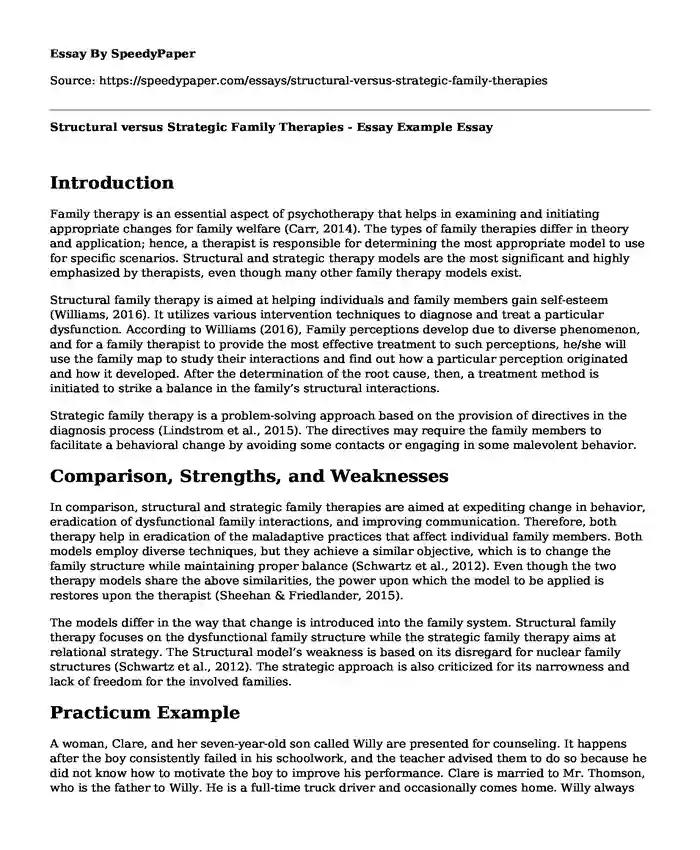
| Type of paper: | Essay |
| Categories: | Psychology Family |
| Pages: | 3 |
| Wordcount: | 753 words |
Introduction
Family therapy is an essential aspect of psychotherapy that helps in examining and initiating appropriate changes for family welfare (Carr, 2014). The types of family therapies differ in theory and application; hence, a therapist is responsible for determining the most appropriate model to use for specific scenarios. Structural and strategic therapy models are the most significant and highly emphasized by therapists, even though many other family therapy models exist.
Structural family therapy is aimed at helping individuals and family members gain self-esteem (Williams, 2016). It utilizes various intervention techniques to diagnose and treat a particular dysfunction. According to Williams (2016), Family perceptions develop due to diverse phenomenon, and for a family therapist to provide the most effective treatment to such perceptions, he/she will use the family map to study their interactions and find out how a particular perception originated and how it developed. After the determination of the root cause, then, a treatment method is initiated to strike a balance in the family’s structural interactions.
Strategic family therapy is a problem-solving approach based on the provision of directives in the diagnosis process (Lindstrom et al., 2015). The directives may require the family members to facilitate a behavioral change by avoiding some contacts or engaging in some malevolent behavior.
Comparison, Strengths, and Weaknesses
In comparison, structural and strategic family therapies are aimed at expediting change in behavior, eradication of dysfunctional family interactions, and improving communication. Therefore, both therapy help in eradication of the maladaptive practices that affect individual family members. Both models employ diverse techniques, but they achieve a similar objective, which is to change the family structure while maintaining proper balance (Schwartz et al., 2012). Even though the two therapy models share the above similarities, the power upon which the model to be applied is restores upon the therapist (Sheehan & Friedlander, 2015).
The models differ in the way that change is introduced into the family system. Structural family therapy focuses on the dysfunctional family structure while the strategic family therapy aims at relational strategy. The Structural model’s weakness is based on its disregard for nuclear family structures (Schwartz et al., 2012). The strategic approach is also criticized for its narrowness and lack of freedom for the involved families.
Practicum Example
A woman, Clare, and her seven-year-old son called Willy are presented for counseling. It happens after the boy consistently failed in his schoolwork, and the teacher advised them to do so because he did not know how to motivate the boy to improve his performance. Clare is married to Mr. Thomson, who is the father to Willy. He is a full-time truck driver and occasionally comes home. Willy always complains of his father being away and not finding enough time to spend with family. Even those rare occasions when Mr. Thomson was at home, he hardly spent time together with his son. Willy complains that his friends were making fun of him at school because his father never bought him a present. He wondered why his father hated him and kept on asking his mother questions. Clare’s relationship with Mr. Thomson was okay despite a few typical marriage conflicts.
Recommended Family Therapy
Strategic family therapy is the most strategic intervention in this scenario. According to Becvar & Becvar (2013), it is necessary to change the hierarchy of the family to help the child transform. This model will help the uninvolved parent, Mr. Thomson, to change and create more time to spend with his son and establish a bond hence creating new interactions (Carr, 2014). This intervention will improve Willy’s attitude towards his father, which will, in turn, advance his education and social performance.
References
Becvar, D. S., & Becvar, R. J. (2013). Family therapy: A systemic integration. Pearson Education.
Carr, A. (2014). The evidence base for family therapy and systemic interventions for childfocused problems. Journal of family therapy, 36(2), 107-157.
Lindstrom, M., Filges, T., & Jorgensen, A. K. (2014). Brief strategic family therapy for young people in treatment for drug use. Research on Social Work Practice, 25(1), 61-80. doi: 10.1177/1049731514530003
Schwartz, S. J., Muir, J. A., & Brown, C. H. (2012). Brief strategic family therapy: An intervention to reduce adolescent risk behavior. Couple and Family Psychology, Research and Practice, 1(2), 134-145. doi: 10.1037/a0029002
Sheehan, A. H., & Friedlander, M. L. (2015). Therapeutic alliance and retention in brief strategic family therapy: A mixed-methods study. Journal of Marital and Family Therapy, 41(4), 415-427. doi: 10.1111/jmft.12113
Williams, A. E. (2016). The viability of structural family therapy in the twenty-first century: An analysis of key indicators. Contemporary Family Therapy, 38(3), 255-261. doi: 10.1007/s10591-016-9383-9.
Cite this page
Structural versus Strategic Family Therapies - Essay Example. (2023, Dec 27). Retrieved from https://speedypaper.net/essays/structural-versus-strategic-family-therapies
Request Removal
If you are the original author of this essay and no longer wish to have it published on the SpeedyPaper website, please click below to request its removal:
- What Brings Joy In My Life? Personal Essay Example
- Essay Sample: Admission Letter for Kindergarten
- Paper Example: What Enhances Learning
- Free Essay. The Birth of a Child
- Asking About the Relationship - Paper Example
- Essay Sample on Research Method and Design
- Essay Sample on Motivation in The Work Place
Popular categories




